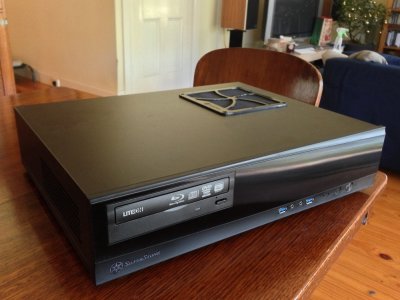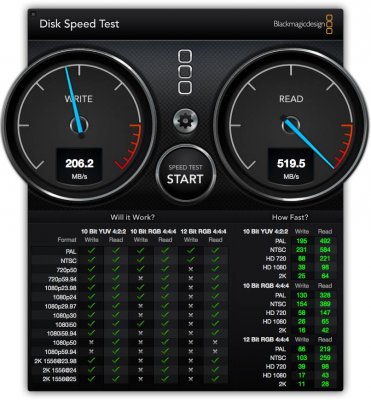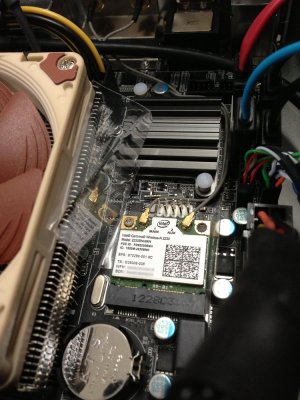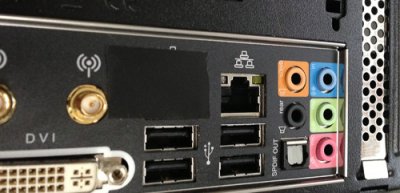Ok, latest updates on this build...

You can see the slight blacking I've applied to the white logo on the case. I've done the same to the blue LEDs just to tone them down a bit. This is a work in progress: I'll clean it up a little more later.
CPU speeds
The i3-3225 is billed as a 3.3 GHz processor. Indeed, the GA-H77N-WIFI BIOS configuration has the base clock set at 100 MHz, and the core multiplier to 33.
However despite the setting, the BIOS reports the current core clock as 99 MHz. This explains why the CPU frequency as reported in HWMonitor ranges from 1.584 GHz (16x multiplier) up to 3.267 Ghz (33x multiplier). There doesn't seem to be anything we can do about this, other than noting that the processor is running 1% slower than it could be.
SSD
Last weekend I installed a 64 GB SanDisk SSD as the new boot disk. The drive was fairly cheap, removing the old 120 GB HDD has reduced the noise-makers inside the case, and booting the machine is a lot faster now. It doesn't affect the speed of the machine in use much (once apps are started) but it does make it more convenient for me when experimenting and rebooting.
I did of course install the SSD on a 6 Gbps port:

New drive layout:
- 64 GB SSD: Boot drive
- 250 GB HDD: 64 GB clone partition, with the remainder for Time Machine backups
- 500 GB HDD: Video recordings and buffers
Remove sleepimage
I should have done this earlier of course. Don't assume that as a "desktop" system the hibernate mode defaults to 0 ("soft sleep" only) as it does on Apple systems. You will need to set this on every machine you don't intend to use hibernation on.
Code:
sudo pmset -a hibernatemode 0
sudo rm /var/vm/sleepimage
Note that hibernation is where the RAM contents are pushed out to a file so the power can be turned off. This is the ultimate in power-saving functions, but it does require a little time to restart from sleep. It also chews up a chunk of drive space (8 GB in this case, matching the amount of RAM in the machine).
hibernatemode=0 doesn't disable sleep entirely, it just disables "deep" sleep where power can be turned off.
Temperatures
Ran Prime95/small as a stress-test. On a 25C day the core temps stabilised just over 60C, with the fans still making hardly any noise. That's OK with me. Usual temps even under load don't go anywhere near that. This was just a bit of a comparison after overclocking and tuning my lammergeier build.
One thing I did notice was the Northbridge (H77) temperature after boot crept steadily up to 60C, even with the machine relatively idle. The reason for this is obvious in hindsight: no airflow over the H77's heatsink. The PSU's airflow is separate from the case (in the bottom and out the back) so the only other fan is the CPU cooler's. The NH-L9i cooler blows air down into the CPU heatsink, and it's then channeled outwards by the heatsink fins. When I first assembled the machine I installed the cooler with the fins oriented front/back, which provided some airflow towards the RAM and some towards the power regulators.
The air blowing towards the RAM would only reach the first RAM module, and as an experiment I reinstalled the NH-L9i rotated by 90 degrees, so there's a slight draft over the edge of the H77. The Northbridge temps dropped by almost 10C! As expected, even a slight movement of air helps the heatsink radiator do its job. The WiFi card doesn't need much cooling, so next I built a simple baffle to redirect more airflow sideways to the Northbridge. I made it from some plastic I had lying around so it's a bit hard to see in this photo. But by channelling more of that air sideways over the H77 it's dropped the average temperature by another 4-5 degrees.
This photo is facing towards the back plate of the machine. You can see where the fins of the CPU cooler would direct air across the edge of the grey H77 heatsink, and the plastic baffle which is directing just a bit more air in that direction.

The baffle is a sheet which runs under the mini-PCIe card (the screw goes through it) and is then folded upwards at an angle. I'm sure a more-effective airguide could be designed: this was a quick hack.
My other option was to install a quiet 80mm fan at the side of the case (which already has mounts for four of them) powered by the motherboard's SYS_FAN connector and blowing a gentle breeze across the rear of the motherboard. But I'll hold off on that for now.
While I had the board out of the case I took a close look at where the WiFi/BT antenna pigtails led. canyoncliffs had already (identified for us) that the antenna connection nearest the HDMI port is the one used for Bluetooth. It turns out this is connected to the AUX port on the mini-PCIe card, which makes sense.
Taped one LAN port
This machine needs to have a static IP address (it's accessed from the internet via port forwarding on the local router). The simplest way of ensuring this is to use the same LAN port every time. But with two LAN ports at the rear of the machine, it's easy to connect a cable into a random choice when rearranging the system.
Simple solution: place some tape over the unused port. Black electrical tape blends in nicely with the black rear plate, and it's stopped me making a mistake several times already.





